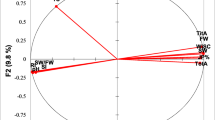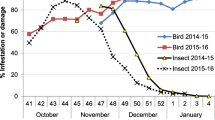Abstract
In laboratory experiments the suitability of six fruits of indigenous trees and shrubs, which are also available in the field during wintertime, was tested as food and development medium for ten stored products insects.
Undamaged fruits of oaks (Quercus robur andQu. borealis), horse chestnuts (Aesculus bippocastanum) and beech (Fagus sylvatica) could not be attacked by any of the tested beetles and moths.
Damaged or peeled fruits ofQu. robur andF. sylvatica, however, served as development medium for seven pests. The least fitted substrates were hipberries (Rosa canina) and acorns ofQu. borealis.
The number of adults emerging from the wild fruits was normally lower than that from control mediums. An exception was found inSitophilus granarius developing in acorns ofQu. robur.
Oryzaephilus surinamensis, Stegobium paniceum, Ephestia kuehniella andPlodia interpunctella had the broadest food spectrum with five fruits each.
The beechnut offered the best possibilities for development. Only those insects living inside of seeds (Sitophilus granarius, S. oryzae andSitotroga cerealella) were not able to form a new generation in this fruit.
The influence upon the length of the development period was different according to fruit and pest species. The slightest difference, compared with a normal medium (rolled oat, wheat bran and glycerine) was found in the mediterraneum flour moth (E. kuehniella).
As stored products insects can be found relatively often in outdoor biotopes, especially in the surrounding of silos or stores, it can not be excluded that fruits of wild plants may offer—at least for a certain period—a possibility for survival. Thus they may act from time to time as a source of infestation.
Zusammenfassung
In Laboratoriumsuntersuchungen wurde die Eignung von sechs auch im Winter im Freien vorkommenden Wildfrüchten als Entwicklungs- und Fraßmedium für zehn Vorratsschädlinge getestet.
Unbeschädigte Früchte von Stieleiche (Quercus robur), Roteiche (Qu. borealis), Roßkastanie (Aesculus hippocastanum) und Buche (Fagus sylvatica) konnten von keiner der geprüften Käfer- und Mottenarten befallen werden.
An oder in beschädigten oder geschälten Früchten von Stieleiche und Buche konnten sich jeweils sieben Vorratsschädlinge entwickeln. Am wenigsten waren Hagebutte und Roteichel als Entwicklungsmedium geeignet.
Die Schlüpfrate lag fast immer unter der in der Kontrolle. Nur beiSitophilus granarius schlüpften aus Stieleicheln mehr Imagines als aus Kontrollweizen.
Das breiteste Nahrungsspektrum hatten im VersuchOryzaephilus surinamensis, Stegobium paniceum, Ephestia kuehniella undPlodia interpunctella mit je 5 der 6 getesteten Wildfrüchte.
Die Buchecker bot allgemein die beste Entwicklungsmöglichkeit. Nur die Arten mit Innenbefall (Sitophilus granarius, S. oryzae undSitotroga cerealella) konnten an ihr keine neue Generation aufbauen.
Der Einfluß auf die Entwicklungsdauer war je nach Wildfrucht und Schädling sehr unterschiedlich. Am wenigsten wich sie beiEphestia kuehniella von der normalen Dauer (an einem Gemisch aus Haferflocken, Weizenkleie und Glyzerin) ab.
Da Vorratsschädlinge relativ häufig im Freiland gefunden werden können, vor allem in der Nähe von Silos und anderen Vorratslagern, ist nicht auszuschließen, daß Wildfrüchte ihnen eine zeitweise Überlebensmöglichkeit bieten und so, wenn auch sicher relativ selten, als Infestationsquelle dienen können.
Similar content being viewed by others
Literaturverzeichnis
Azab, A.K., 1954: Observations on the biological races ofStegobium paniceum L. Bull. Soc. Fouad Ier Entom.38, 59–80.
Braun, S.R., 1989: Zur Frage der Anpassung vonStegobium paniceum (L.) (Col.; Anobiidae) an verschiedene Zuchtsubstrate. Ein Beitrag zum Problem der Rassenbildung. Wiss. Fachverlag Gießen, 90S.
Buckland, P.C., 1981: The early dispersal of insect pests of stored products as indicated by archaeological records. J. stored Prod. Res.17, 1–12.
Collins, P.J.;Sinclair, E.R.;Howitt, C.J.; Haddrell, R.L., 1988: Dispersion of grain beetles (Coleoptera) in grain artially treated with insecticide. J. econ. Entomol.81, 1810–1815.
Giesbert, U., 1985: Untersuchungen zur Freilandüberwinterung und Kältetoleranz von adulten Vorratsschädlingen (Coleoptera). Dissertation Gießen.
Haschemi, H.;Stein, W., 1986: Zum Vorkommen von Schaben auf Mülldeponien. Forum-Städte-Hygiene37, 89–94.
Holloway, G.J.;Mackness, M.I., 1988: The evolutionary adaptation of enzyme systems inSitophilus oryzae fed on toxic legumes. Entomol. exp. appl.48, 165–172.
Howe, R.W., 1965:Sitophilus granarius (L.) (Coleoptera, Curculionidae) breeding in acorns. J. stored Prod. Res.1, 99–100.
Linsley, E.G., 1944: Natural sources, habitats, and reservoirs of insects associated with stored food products. Hilgardia16, 187–224.
Madel, W., 1938: Drogenschädlinge, ihre Erkennung und Bekämpfung. Deutscher Apotheker-Verlag Berlin, 96S.
Mills, R.B., 1989:Sitophilus zeamais Motschulsky breeding in acorns. J. Kansas entomol. Soc.62, 416.
Richards, O.W.;Thomson, W.S., 1932: A contribution to the study of the generaEphestia, Gn. (IncludingStrymax, Dyar), andPlodia, Gn. (Lepidoptera, Phycitidae), with notes on parasites of the larvae. Transact. entomol. Soc. London80, 169–247.
Solomon, M.E.;Adamson, B.E., 1955: The power of survival of storage and domestic pests under winter conditions in Britain. Bull. entomol. Res.46, 311–355.
Stein, W., 1986: Vorratsschädlinge und Hausungeziefer. Biologie, Ökologie, Gegenmaßnahmen. Eugen Ulmer Stuttgart, 287S.
Tzanakakis, M.E., 1959: An ecological study of the Indianmeal mothPlodia interpunctella (Hübner) with emphasis on diapause. Hilgardia29, 205–246.
Uhlmann, E., 1937: Unsere Material- und Vorratsschädlinge in ihrer Beziehung zum Freilandleben. Mitt. Ges. Vorratsschutz13, 57–60.
Uhlmann, E., 1938: Unsere Material- und Vorratsschädlinge in ihrer Beziehung zum Freilandleben. Mitt. Ges. Vorratsschutz14, 3–10.
Weidner, H., 1963–1966: Hausinsektenprobleme im Wandel der Zeit. Städtehygiene, verschiedene Aufsätze.
Weidner, H., 1973: Insekten als Schädlinge an Drogen in Apotheken und Drogerien. Anz. Schädlingskde., Pflanzenschutz, Umweltschutz46, 177–180.
Weidner, H., 1983: Herkunft einiger in Mitteleuropa vorkommender Vorratsschädlinge: 1. dieSitophilus-Arten (Coleoptera: Curculionidae). Mitt. Internat. Entomol. Vereine8, 1–17.
Wohlgemuth, R.;Reichmuth, Chr.;Rothert, H.;Bode, E., 1987: Auftreten vorratsschädlicher Motten der GattungenEphestia undPlodia außerhalb von Lägern und lebensmittelverarbeitenden Betrieben in Deutschland. Anz. Schädlingskde., Pflanzenschutz, Umweltschutz60, 44–51.
Zacher, F., 1930: Untersuchungen zur Morphologie und Biologie der Samenkäfer (Bruchidae-Lariidae). Beiträge zur Kenntnis der Vorratsschädlinge. 6. Beitrag. Arb. Biolog. Reichsanst. Land- und Forstwirtschaft Berlin-Dahlem18, 233–384.
Zacher, F., 1937: Vorratsschädlinge und Vorratsschutz, ihre Bedeutung für Volksernährung und Weltwirtschaft. Z. hyg. Zool.29, 193–202.
Author information
Authors and Affiliations
Additional information
Herrn Prof. Dr.J.M. Franz zum 75. Geburtstag gewidmet.
Mit 2 Abbildungen und einer Tabelle
Rights and permissions
About this article
Cite this article
Stein, W. Untersuchungen über die Entwicklung von Vorratsschädlingen an Früchten einheimischer Bäume und Sträucher. Anz. Schadlingskde., Pflanzenschutz, Umweltschutz 63, 41–46 (1990). https://doi.org/10.1007/BF01903462
Issue Date:
DOI: https://doi.org/10.1007/BF01903462




